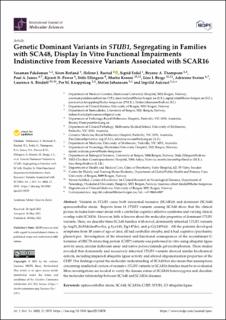| dc.contributor.author | Pakdaman, Yasaman | |
| dc.contributor.author | Berland, Siren | |
| dc.contributor.author | Bustad, Helene J. | |
| dc.contributor.author | Erdal, Sigrid | |
| dc.contributor.author | Thompson, Bryony A. | |
| dc.contributor.author | James, Paul A. | |
| dc.contributor.author | Power, Kjersti | |
| dc.contributor.author | Ellingsen, Ståle | |
| dc.contributor.author | Krooni, Martin | |
| dc.contributor.author | Berge, Line Iden | |
| dc.contributor.author | Sexton, Adrienne | |
| dc.contributor.author | Bindoff, Laurence Albert | |
| dc.contributor.author | Knappskog, Per Morten | |
| dc.contributor.author | Johansson, Stefan | |
| dc.contributor.author | Aukrust, Ingvild | |
| dc.date.accessioned | 2021-08-12T08:09:13Z | |
| dc.date.available | 2021-08-12T08:09:13Z | |
| dc.date.created | 2021-06-16T13:17:11Z | |
| dc.date.issued | 2021 | |
| dc.identifier.issn | 1422-0067 | |
| dc.identifier.uri | https://hdl.handle.net/11250/2767461 | |
| dc.description.abstract | Variants in STUB1 cause both autosomal recessive (SCAR16) and dominant (SCA48) spinocerebellar ataxia. Reports from 18 STUB1 variants causing SCA48 show that the clinical picture includes later-onset ataxia with a cerebellar cognitive affective syndrome and varying clinical overlap with SCAR16. However, little is known about the molecular properties of dominant STUB1 variants. Here, we describe three SCA48 families with novel, dominantly inherited STUB1 variants (p.Arg51_Ile53delinsProAla, p.Lys143_Trp147del, and p.Gly249Val). All the patients developed symptoms from 30 years of age or later, all had cerebellar atrophy, and 4 had cognitive/psychiatric phenotypes. Investigation of the structural and functional consequences of the recombinant C-terminus of HSC70-interacting protein (CHIP) variants was performed in vitro using ubiquitin ligase activity assay, circular dichroism assay and native polyacrylamide gel electrophoresis. These studies revealed that dominantly and recessively inherited STUB1 variants showed similar biochemical defects, including impaired ubiquitin ligase activity and altered oligomerization properties of the CHIP. Our findings expand the molecular understanding of SCA48 but also mean that assumptions concerning unaffected carriers of recessive STUB1 variants in SCAR16 families must be re-evaluated. More investigations are needed to verify the disease status of SCAR16 heterozygotes and elucidate the molecular relationship between SCA48 and SCAR16 diseases. | en_US |
| dc.language.iso | eng | en_US |
| dc.publisher | MDPI | en_US |
| dc.rights | Navngivelse 4.0 Internasjonal | * |
| dc.rights.uri | http://creativecommons.org/licenses/by/4.0/deed.no | * |
| dc.title | Genetic Dominant Variants in STUB1, Segregating in Families with SCA48, Display In Vitro Functional Impairments Indistinctive from Recessive Variants Associated with SCAR16 | en_US |
| dc.type | Journal article | en_US |
| dc.type | Peer reviewed | en_US |
| dc.description.version | publishedVersion | en_US |
| dc.rights.holder | Copyright 2021 by the authors | en_US |
| dc.source.articlenumber | 5870 | en_US |
| cristin.ispublished | true | |
| cristin.fulltext | original | |
| cristin.qualitycode | 1 | |
| dc.identifier.doi | 10.3390/ijms22115870 | |
| dc.identifier.cristin | 1916159 | |
| dc.source.journal | International Journal of Molecular Sciences | en_US |
| dc.identifier.citation | International Journal of Molecular Sciences. 2021, 22 (11), 5870. | en_US |
| dc.source.volume | 22 | en_US |
| dc.source.issue | 11 | en_US |

